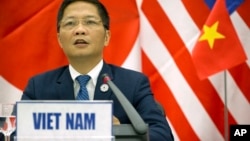Vietnam’s christening this week of the 11-nation Trans Pacific Partnership trade deal, to be followed by a pact with the European Union, will give the export-reliant country tariff-free access to markets totaling 45 percent of the world GDP, its biggest economic boost since joining the World Trade Organization.
The National Assembly in Hanoi ratified the Comprehensive and Progressive Trans Pacific Partnership in November effective January 14, breaking down import tariffs to major markets such as Canada and Japan. The partnership, which Washington dropped in 2017, covers 13.5 percent of the world economy, or about $10 trillion.
Other partnership countries are in the process of ratifying the deal and six others have done it already, giving it high odds of full implementation. Vietnam is also waiting for the European Union, 21.8 percent of the world GDP, to ratify a free trade deal that the two sides negotiated in 2015. The EU expects ratification this year.
The two deals will combine to power Vietnam’s export-driven, fast-growing economy and accelerate growth of its middle class, analysts say.
They say the deals will also make the country more attractive to foreign investors, who might otherwise pick China for factory sites, though Vietnam will need to get tougher on intellectual property and labor to honor the deals.
“Vietnam will enjoy a comparatively lower duty rate in some export markets where it competes,” said Frederick Burke, partner with the law firm Baker McKenzie in Ho Chi Minh City. “It’s hard to say what would be bigger than the WTO, that was really a big bang. But (in 2018) we’ve had already as much foreign direct investment as we did the year of the WTO accession.”
TPP Breakthrough
Vietnam is considered a top beneficiary from the Comprehensive and Progressive Trans Pacific Partnership because of its developing economy and because exports came to an outsized value of $200 billion in 2017. Other countries in the pact would be net importers of Vietnamese-made goods.
Since 1986 the once war-torn country has staked economic progress on foreign investment in factories that make exports from garments to consumer electronics. It entered the WTO in 2008, giving it the same trade rights as 164 other members.
Low-value manufactured goods such as shoes will become cheaper to ship to key Pacific partnership countries such as Australia, said Adam McCarty, chief economist with Mekong Economics in Hanoi.
European and Pacific Rim countries want trade deals with Vietnam so they can better sell imports to its growing middle class, which the Boston Consulting Group expects will reach up to one-third of Vietnam’s 93 million people by next year.
EU-Vietnam trade has quintupled over the past decade, and that deal could boost the Vietnamese GDP by 15 percent, the European Parliament says in a statement. The EU-Vietnam deal has failed ratification to date because of “doubts over the correct ratification procedure” but with hopes of final nods this year, it adds.
The Trans Pacific Partnership further allows Vietnamese to enter the other 10 countries easily for work-related business.
Compliance with non-tariff requirements
As a member of the Pacific partnership, Vietnam must allow independent labor unions, standardize government procurement rules so firms from other partnership countries can make bids, and step up enforcement of intellectual property rights. Experts say Vietnam doesn’t measure up yet.
“TPP for Vietnam, because they’ve signed it and now it’s ratified in the National Assembly, for those who want (to) push reforms, it’s a kind of rod to beat other people’s act to get on the reforms, (saying) ‘we have to meet these international standards,” said Carl Thayer, emeritus professor at the University of New South Wales in Canberra.
Officials in Hanoi want to comply so Vietnam gets the broader Pacific trade pact benefits, said Trung Nguyen, international relations dean at Ho Chi Minh University of Social Sciences and Humanities. “They want get some new momentum for Vietnam’s economy, and TPP is one of the solutions,” he said.
Compliance with non-tariff requirements, especially intellectual property, would further differentiate Vietnam from world factory powerhouse China, McCarty said.
Vietnam already stands out, especially among investors from developed Asian economies, over China for its lower labor costs. China also lacks independent labor unions and struggles with intellectual property rights enforcement, a sticking point in the broader Sino-U.S. trade dispute that dominated 2018.
“The terms and conditions of membership make it unattractive for China to be a member” of the Pacific parternship, McCarty said. “A lot of it’s to do with intellectual property rights, and all the things Mr. Trump is asking them for at the moment. It’s also labor rights. You’re supposed to offer corporate-grade unions under the TPP, something that China couldn’t sign up to.”








